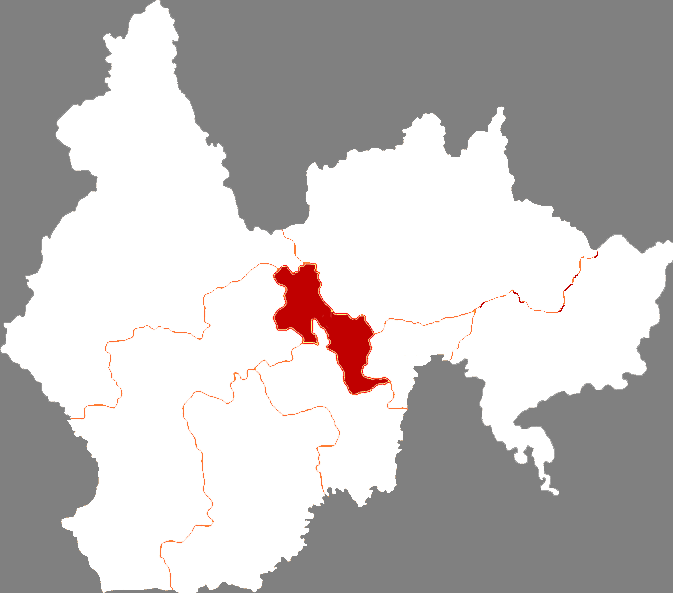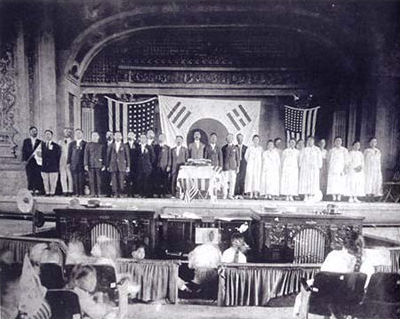|
Righteous Army Command
The Righteous Army Command () was a monarchist independence movement group organized in Manchuria in 1919. Their military foundation was based on the former Righteous Army fighters who escaped to Manchuria after failing to retake Seoul from the Japanese Empire. They were known for fighting alongside militant independence groups at several major battles against the Japanese. When they joined the Korean Unification Government, they came into conflict with them due to ideological differences between monarchism and republicanism which led to several bloody conflicts. Eventually they withdrew from the government to establish themselves as an autonomous organization, but due to the rise in democracy and socialism their power waned and they disbanded to joined the other autonomous organizations. Background Late Joseon dynasty period Korean nationalism outgrew the unplanned, spontaneous, and disorganized Donghak Peasant Revolution, Donghak movement, and became more violent as Japanese c ... [...More Info...] [...Related Items...] OR: [Wikipedia] [Google] [Baidu] |
Provisional Government Of The Republic Of Korea
The Korean Provisional Government (KPG), formally the Provisional Government of the Republic of Korea, was a partially recognized Korean government-in-exile based in Shanghai, China, and later in Chongqing, during the period of Japanese colonial rule in Korea. On 11 April 1919, a provisional constitution providing for a democratic republic named the "Republic of Korea" was enacted. It introduced a presidential system and three branches (legislative, administrative and judicial) of government. The KPG inherited the territory of the former Korean Empire. The Korean resistance movement actively supported the independence movement under the provisional government, and received economic and military support from the Kuomintang ("Chinese Nationalist Party"), the Soviet Union, and France. After the surrender of Japan on 15 August 1945, figures such as Kim Gu returned. On 15 August 1948, the Provisional Government of the Republic of Korea was dissolved. Syngman Rhee, who was the ... [...More Info...] [...Related Items...] OR: [Wikipedia] [Google] [Baidu] |
Siberia
Siberia ( ; rus, Сибирь, r=Sibir', p=sʲɪˈbʲirʲ, a=Ru-Сибирь.ogg) is an extensive geographical region, constituting all of North Asia, from the Ural Mountains in the west to the Pacific Ocean in the east. It has been a part of Russia since the latter half of the 16th century, after the Russians conquered lands east of the Ural Mountains. Siberia is vast and sparsely populated, covering an area of over , but home to merely one-fifth of Russia's population. Novosibirsk, Krasnoyarsk and Omsk are the largest cities in the region. Because Siberia is a geographic and historic region and not a political entity, there is no single precise definition of its territorial borders. Traditionally, Siberia extends eastwards from the Ural Mountains to the Pacific Ocean, and includes most of the drainage basin of the Arctic Ocean. The river Yenisey divides Siberia into two parts, Western and Eastern. Siberia stretches southwards from the Arctic Ocean to the hills of north-ce ... [...More Info...] [...Related Items...] OR: [Wikipedia] [Google] [Baidu] |
Korean Independence Army
The Korean Independence Army () was an independent military force organized in Northern Jiandao (Gando) in 1919 and led by Hong Beom-do, a former gunner. This unit played major roles in defeating the Japanese in the Battle of Fengwudong and Battle of Qingshanli. Background Hong led the Korean Righteous Army to several victories, beginning in 1907, at Gaksan, Samsu, and Bukcheong. These successes eventually led to increased attacks by the Japanese Army, which caused the Korean Independence Army to withdraw in 1910 to Primorsky and Kando. From a safer location inside Russia, Hong continued his campaign against the Japanese. In August 1918, when Japan invaded Primorsky in support of the White Army during the Russian civil war, Hong formed a military force centered around the former Korean Independence Army and Korean people living in Manchuria. Organization When the March 1st Movement took place in 1919, Hong and his soldiers moved to Antuhyun. In 1919, the Korean Independence Ar ... [...More Info...] [...Related Items...] OR: [Wikipedia] [Google] [Baidu] |
Ahn Chang-ho
Ahn Changho, sometimes An Chang-ho (; , November 9, 1878 – March 10, 1938) was a Korean independence activist and one of the early leaders of the Korean-American immigrant community in the United States. He is also referred to by his pen name Dosan (도산; 島山 ). A Protestant social activist, he established the Shinminhoe (New Korea Society) when he returned to Korea from the US in 1907. It was the most important organization to fight the Japanese occupation of Korea. He established the Young Korean Academy (흥사단; 興士團) in San Francisco in 1913 and was a key member in the founding of the Provisional Government of the Republic of Korea in Shanghai in 1919. Ahn is one of two men believed to have written the lyrics of "Aegukga", the South Korean national anthem. Besides his work for the Independence Movement, Dosan wanted to reform the Korean people's character and the entire social system of Korea. Dosan's key efforts were in educational reforms and modernizing. ... [...More Info...] [...Related Items...] OR: [Wikipedia] [Google] [Baidu] |
Democratic Republic
A democratic republic is a form of government operating on principles adopted from a republic and a democracy. As a cross between two exceedingly similar systems, democratic republics may function on principles shared by both republics and democracies. While not all democracies are republics (constitutional monarchies) and not all republics are democracies, common definitions of the terms ''democracy'' and ''republic'' often feature overlapping concerns, suggesting that many democracies function as republics, and many republics operate on democratic principles, as shown by these definitions from the ''Oxford English Dictionary'': * ''Republic'': "A state in which supreme power is held by the people and their elected representatives, and which has an elected or nominated president rather than a monarch." * ''Democracy'': "A system of government by the whole population or all the eligible members of a state, typically through elected representatives." Eugene Volokh of the UCLA School ... [...More Info...] [...Related Items...] OR: [Wikipedia] [Google] [Baidu] |
Shanghai
Shanghai (; , , Standard Mandarin pronunciation: ) is one of the four direct-administered municipalities of the People's Republic of China (PRC). The city is located on the southern estuary of the Yangtze River, with the Huangpu River flowing through it. With a population of 24.89 million as of 2021, Shanghai is the most populous urban area in China with 39,300,000 inhabitants living in the Shanghai metropolitan area, the second most populous city proper in the world (after Chongqing) and the only city in East Asia with a GDP greater than its corresponding capital. Shanghai ranks second among the administrative divisions of Mainland China in human development index (after Beijing). As of 2018, the Greater Shanghai metropolitan area was estimated to produce a gross metropolitan product (nominal) of nearly 9.1 trillion RMB ($1.33 trillion), exceeding that of Mexico with GDP of $1.22 trillion, the 15th largest in the world. Shanghai is one of the world's major centers for ... [...More Info...] [...Related Items...] OR: [Wikipedia] [Google] [Baidu] |
Korean Independence Corps
The Korean Independence Corps () is a militant Korean independence organization that united the Korean Independence armies until its dissolution after the Free City Incident, reorganization in Manchuria, and its final dissolution. Overview As Japan launched a full-fledged attack following defeats such as the Battle of Cheongsanri and the Battle of Fengwudong, independence forces, including the Northern Military Administration Office, decided to move to the Maritime Province and prepare for a long-term anti-Japanese war, and in 1920. It is a joint unit that united the forces of the independence army in December at Milsan near the Sino-Soviet border. Background At the request of the Chinese side, which could not overcome the pressure of Japan, the independence army units located in all parts of South and North Manchuria, especially in North Gando, moved to the direction of Milsan near the Sino-Soviet border to build a new anti-Japanese war base. In December 1920, under the ... [...More Info...] [...Related Items...] OR: [Wikipedia] [Google] [Baidu] |
Korean Democratic Corps
The Korean Democratic Corps (), also known as the Shinminhoe, Daehan Shinminhoe, or Shinmindan, was a Protestant-affiliated armed independence movement group organized in Vladivostok, Primorsky Krai and East Manchuria in March 12, 1919. It was led by Director Kim Gyu-myeon, Vice Director Han Gwang-taek, General Affairs Director Choi Sang-jin, Finance Director Lee Jon-su, and Foreign Affairs Director Kim Deok-bo were appointed. History When the March 1st Declaration of Independence was proclaimed, they attempted to expand their organization in order to prepare for an independence war and effectively develop a cultural movement to seize the country. Afterwards, about 40 district organizations and 20,000 members were secured in Manchuria, Noryeong, and Korea. They instilled patriotism in their members through educational activities, and opened the way for them to study by creating farmers' movements and food industry cooperatives. Meanwhile, two branches were newly established ... [...More Info...] [...Related Items...] OR: [Wikipedia] [Google] [Baidu] |
Northern Military Administration Office
The Northern Military Administration Office () was an armed independence movement group founded in Donggandao in 1919. It originated from the Daejonggyo lineage. It was organized around Seo Il and Kim Jwa-jin in Jilin Province, Manchuria, in 1919. Based on the Junggwangdan organized by Koreans who immigrated to Bukgando, the Jeongjeongdan organized in Bukgando in 1919 was established by changing its name to Northern Military Administration Office. The Northern Military Administration Office established an officer training center to conduct military training and train independence fighters. In 1920, when Japan deployed its troops into Manchuria, it achieved a great victory over the Japanese army in the Battle of Cheongsanri. Overview The Korean Military Government was created by merging the Korean Justice Corps and its affiliated Korean Military Government Association in 1919. In October 1919, under the leadership of Daejongism, Daejonggyo and New People's Association, Shinminho ... [...More Info...] [...Related Items...] OR: [Wikipedia] [Google] [Baidu] |
Gando National Association
The Gangdo National People's Association () was a group in the Korean independence movement in Manchuria organized in 1914. It was formed in exile during the Japanese occupation of Korea. While focusing on educational movements such as building elementary schools and middle schools, the March 1st Movement in 1919 began full-scale activities. Background Initially, the name of the association was Ganmin Autonomous Association (墾民自治會), but the Chinese authorities requested that the word "autonomy" be deleted, so it was renamed Ganminhoe. On January 26, 1913, 25 founders, including Lee Dong-chun and Kim Lip, held a meeting to establish a community association with about 150 people in attendance. On April 26, Baek Ok-bo (白玉甫) was elected as the temporary president of the Ganminhoe General Assembly and held a meeting to establish the Ganminhoe. At this convention, Kim Yak-yeon (金躍淵) was elected as president and Baek Ok-bo was elected as vice president. In addit ... [...More Info...] [...Related Items...] OR: [Wikipedia] [Google] [Baidu] |
Jiandao
Jiandao or Chientao, known in Korean as Gando or Kando, is a historical border region along the north bank of the Tumen River in Jilin Province, Northeast China that has a high population of ethnic Koreans. The word "Jiandao" itself, literally "Middle Island", was initially referred to a shoal in Tumen River between today's Chuankou Village, Kaishantun in Longjing, Jilin, China and Chongsŏng, Onsong County in North Korea. The island was an important landmark for immigrants from the Korean Peninsula looking for settlements across the river. As the number of immigrants increased, the area that the word "Jiandao" gradually changed to reflect the areas of Korean settlement. In the early 20th century, an expanding Japanese Empire argued that ethnic Koreans living in this area should be placed under its jurisdiction. As one of its first set of attempts to annex northeast China and conquer other parts of mainland China, Imperial Japanese forces in Korea invaded Jiandao in 1907, bu ... [...More Info...] [...Related Items...] OR: [Wikipedia] [Google] [Baidu] |


